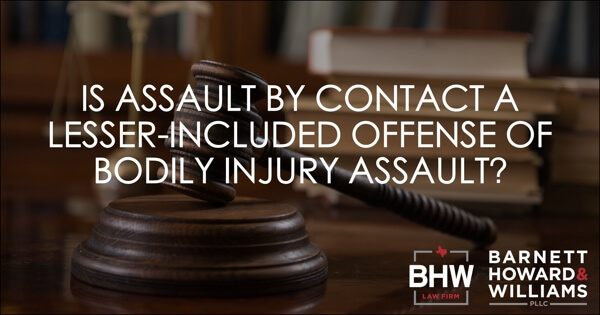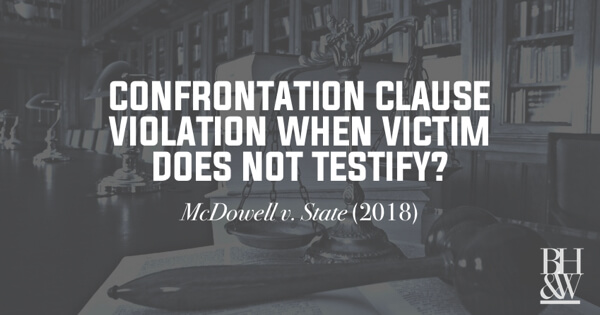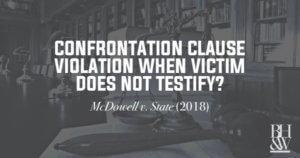Put Up Your Dukes! Here’s What Texans Need to Know Before They Decide to Engage in a Fistfight.
 It’s no secret that folks don’t always get along. Sometimes, especially down in Texas, arguments can lead to fights. When two adults decide to go to fisticuffs, they can reasonably assume that one (or both) of them are going to get hit. But, are the bruises and black eyes the end of it? Can either of these heroes be charged with a criminal offense for their part in the fight? Maybe. It depends.
It’s no secret that folks don’t always get along. Sometimes, especially down in Texas, arguments can lead to fights. When two adults decide to go to fisticuffs, they can reasonably assume that one (or both) of them are going to get hit. But, are the bruises and black eyes the end of it? Can either of these heroes be charged with a criminal offense for their part in the fight? Maybe. It depends.
Consent as a Defense to a Texas Assault Charge
Section § 22.06 of the Texas Penal Code governs consent as a defense to assaultive conduct. This section allows a party accused of assault or aggravated assault or deadly conduct in violation of sections § 22.01, § 22.02 or § 22.05 of the penal code to assert consent of the victim as an affirmative defense to prosecution so long as serious bodily injury is not inflicted and the assaultive conduct is not a requirement of membership in a criminal street gang. While Section § 22.06 is a defense, it does not grant an actor automatic immunity from prosecution. Ultimately, whether both parties to a fistfight demonstrate consent or the reasonable appearance of consent is a fact-intensive inquiry and is a matter for a jury to decide.
-An Illustration-
In Miller v. State, a father and his adult son engaged in fisticuffs over the usual father-son trivialities. The son admitted in an affidavit to egging his father on, inviting him to “come on, hit me,” lunging at his father in a threatening manner and pushing him. The father hit his adult son, bloodying his face and loosening some teeth. After their fight, the bloodied son was discovered by police offers conducting a routine traffic stop. The father was charged with assault in violation of the Texas Penal Code § 22.01. At trial, the father requested a jury instruction on consent but was denied. He was convicted of assault and appealed. The Court of Appeals, Houston 14th District, reversed the trial court, finding that a jury instruction on consent was appropriate given the facts of the case.[1]
What Constitutes Consent to a Fistfight in Texas?
The consent defense to assaultive conduct applies both when the victim gives effective consent to engage in mutual combat as well as when the actor has a “reasonable belief” of the victim’s consent.[2] When evaluating whether a consent defense might apply, courts look to the circumstantial evidence surrounding the fracas. This evidence is evaluated in the light most favorable to the defendant and must merely support the defense’s assertion of the victim’s consent, it does not necessarily have to be believable. Evaluating the credibility of the alleged consent is a question for the jury.[3]
Though juries must be given instruction on consent if the evidence calls for it, the “true meaning” of a combatant’s words are a variable to be considered. In a decision decided on a technicality the court recognized that words like “go ahead,” “come on,” “slap me,” “do it” were not indicative of consent but were “a backhanded warning of potentially dire consequences to the threatener” in those particular circumstances.[4] The court agreed, however, that this is a question for juries to consider with a consent instruction.
In Miller v. State, the victim son, invited his father to “come on, hit me.” The son later explained to police that he was “all jazzed up” and eager for a fight. The victim then kicked and punched his father before his father punched his son. The appellate court took the provocations of the victim to be a part of the calculus for determining mutuality.[5] It is also notable that no parties called the police, that the police encountered the situation through happenstance and pressed charges on their own authority.
What Constitutes “Serious Bodily Harm” Under Texas Law?
Consent is not a defense to assaultive conduct that results in serious bodily harm. Serious bodily harm is defined as “bodily injury that creates a substantial risk of death or that causes death, serious permanent disfigurement, or protracted loss or impairment of the function of any bodily member or organ.”[6] Courts have not produced a definitive demarcation line on what types of assaultive conduct constitute serious bodily harm and what fall short. Serious bodily harm is evaluated on a case-by-case basis[7] accounting for the “disfiguring and impairing quality of the bodily injury.”[8] Injuries are evaluated at the time of the infliction, irrespective of subsequent ameliorating treatment.[9]
Courts have found that the loss of teeth can constitute a serious bodily harm when paired with a sore neck and a week-long hospital stay[10] however, so far, courts have only found the loosening of teeth to rise to the level of serious bodily injury when paired with other serious injuries including fractured facial bones.[11] Blows to the head may or may not constitute serious bodily harm depending on whether they lead to concussion. Similarly, memory loss may or may not constitute serious bodily harm depending on whether it is a product of concussion.[12] Ultimately, if the State alleges serious bodily harm, it is a question of fact for the jury to decide.[13]
In Miller v. State, the state did not allege serious bodily harm and the Court found that the loosening of teeth and the temporary loss of consciousness with no accompanying memory loss did not rise to the level of serious bodily harm.
Jury Instructions On Consent Are Mandatory When Supported By Evidence
In a prosecution for assault, aggravated assault, or deadly conduct in violation of sections § 22.01, § 22.02, or § 22.05 of the Texas Penal Code, the judge must give the jury an instruction on consent and, when charged by the prosecution, serious bodily injury, if the accused has raised any evidence supporting the defense.[14]
“An accused has the right to an instruction on any defense raised by the evidence, whether that evidence is weak or strong, unimpeached or contradicted, and regardless of what the trial court thinks about the credibility of the evidence.”[15]
It is the purview of the jury to determine whether or not the accused had a reasonable belief of consent before engaging in combative behavior. Once the issue of consent is submitted to the jury, the court shall charge the jury that reasonable doubt on the issue requires that the defendant be acquitted.[16]
-Conclusion-
Though a fistfight between consenting adults may well fall into the excepted area carved out by Section § 22.06 of the Texas Penal Code, there are many pitfalls that ought to be avoided. When two parties enter into combat it can sometimes be difficult to establish the mutuality of consent. While consent can be implied from the actions of the participating parties including threatening and inviting speech or belligerent physical action, the more explicit the assertion of consent, the better. If there is sufficient doubt about one party’s eagerness to enter into combat, the consent defense may not apply.
Additionally, when engaging in consensual mutual combat, care must be taken by both parties to not traverse the divide between simple assault and serious bodily harm. Because of the nebulous nature of what constitutes serious bodily harm and the unpredictability in how courts interpret the statute, this can be an especially tricky area to navigate. The difference between a loose tooth and a lost tooth may mark the difference between whether § 22.06 applies.
Finally, both the consent of the parties as well as the gravity of the injuries inflicted are questions for a jury to decide. Though § 22.06 should be introduced as an instruction for a jury to consider when supported by evidence, a person accused of assault still may likely have to undertake the time and expense of a criminal prosecution.
[1] Miller v. State, 312 S.W.3d 209 (Tex. App. – Houston [14th District] 2010).
[2] § 22.06.
[3] 312 S.W.3d at 212.
[4] Allen v. State, 253 S.W.3d 260, 268 (Tex. Crim. App. 2008).
[5] 312 S.W.3d at 211.
[6] Tex. Penal Code Ann. § 1.07 (West).
[7] 312 S.W.3d at 213.
[8] Blea v. State, 483 S.W.3d 29, 34–35 (Tex. Crim. App. 2016).
[9] Goodman v. State, 710 S.W.2d 169, 170 (Tex.App.-Houston [14th Dist.] 1986, no pet.).
[10] Hatfield v. State, 377 S.W.2d 647, 648 (Tex. Crim. App. 1964).
[11] Pitts v. State, 742 S.W.2d 420, 421 (Tex. App. – Dallas 1987).
[12] Powell v. State, 939 S.W.2d 713, 718 (Tex.App.-El Paso 1997, no pet.).
[13] 312 S.W.3d at 213.
[14] Tex. Penal Code Ann. § 2.03 (West).
[15] Id. at 212.
[16] § 2.03.

 An offensive-contact assault not a lesser-included offense of a bodily-injury assault because the offenses have different elements.
An offensive-contact assault not a lesser-included offense of a bodily-injury assault because the offenses have different elements.

 The Second Court of Appeals recently released a memorandum opinion, which reversed a defendant’s conviction due to a confrontation clause violation. The issue was whether the trial court (Criminal District Court Number 1, Tarrant County) erred in allowing an officer to testify about certain statements the alleged victim made regarding a prior assault allegation.
The Second Court of Appeals recently released a memorandum opinion, which reversed a defendant’s conviction due to a confrontation clause violation. The issue was whether the trial court (Criminal District Court Number 1, Tarrant County) erred in allowing an officer to testify about certain statements the alleged victim made regarding a prior assault allegation.
 It’s no secret that folks don’t always get along. Sometimes, especially down in Texas, arguments can lead to fights. When two adults decide to go to fisticuffs, they can reasonably assume that one (or both) of them are going to get hit. But, are the bruises and black eyes the end of it? Can either of these heroes be charged with a criminal offense for their part in the fight? Maybe. It depends.
It’s no secret that folks don’t always get along. Sometimes, especially down in Texas, arguments can lead to fights. When two adults decide to go to fisticuffs, they can reasonably assume that one (or both) of them are going to get hit. But, are the bruises and black eyes the end of it? Can either of these heroes be charged with a criminal offense for their part in the fight? Maybe. It depends.
 One of the highest-profile hate crimes in the nation to occur in recent years involved
One of the highest-profile hate crimes in the nation to occur in recent years involved 
 Did Rougned Odor Assault Jose Bautista Under Texas Law?
Did Rougned Odor Assault Jose Bautista Under Texas Law?
 In
In 
 Except for the military context, you’ve always heard that a jury verdict must be unanimous, right? Well, not exactly.
Except for the military context, you’ve always heard that a jury verdict must be unanimous, right? Well, not exactly.
 Issue presented to the Court: Whether Appellant’s state court assault conviction qualified as a “misdemeanor crime of domestic violence” thereby prohibiting him from possessing a firearm under federal law (18 U.S.C. §922(g)(9)).
Issue presented to the Court: Whether Appellant’s state court assault conviction qualified as a “misdemeanor crime of domestic violence” thereby prohibiting him from possessing a firearm under federal law (18 U.S.C. §922(g)(9)). Faced with the question of whether Reckless Driving is a lesser-included offense of Aggravated Assault With a Motor Vehicle (alleged as a Deadly Weapon), the Texas Court of Criminal Appeals explained that there are, indeed, many ways in which a vehicle can be used as a deadly weapon apart from the vehicle being driven, to wit:
Faced with the question of whether Reckless Driving is a lesser-included offense of Aggravated Assault With a Motor Vehicle (alleged as a Deadly Weapon), the Texas Court of Criminal Appeals explained that there are, indeed, many ways in which a vehicle can be used as a deadly weapon apart from the vehicle being driven, to wit:





